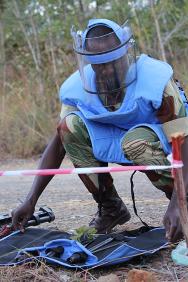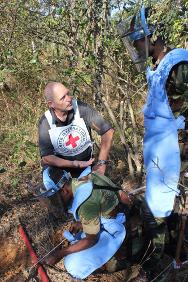Zimbabwe: strengthening humanitarian mine action
17-07-2012 Interview
Over 1.5 million anti-personnel mines still lie in wait along Zimbabwe's borders with Mozambique. Since 1980, they have killed over 1,500 people and 120,000 head of livestock. Michael Berril is the ICRC’s expert on weapons contamination in Harare. As he ends his posting in the country, he explains how the joint initiative between the ICRC and the Zimbabwean government will boost efforts to clear anti-personnel mines and improve the lives of communities.
What is the humanitarian impact of anti-personnel mines in Zimbabwe?
These anti-personnel mines are a legacy of the liberation war of the 1970s. As well as killing and injuring people and livestock, they deny farmers access to vital land in rural communities. According to the Zimbabwe Mine Action Centre (ZIMAC), anti-personnel mines have killed more than 1,500 people and 120,000 livestock since 1980. And they estimate that there are 1.5 to 1.8 million anti-personnel mines that still need to be cleared in Zimbabwe. A significant amount of demining was carried out between 1980 and 2000. Since then, the Zimbabwean government has continued to carry out demining, but in smaller areas and with very limited human and technical resources.
What is humanitarian mine action?
Humanitarian mine action involves clearing anti-personnel mines in order to reduce the devastating effects that they have on people’s lives. We use the best clearance practices in terms of training, equipment and quality management to achieve this goal.
What is the ICRC's role in humanitarian mine action?
The ICRC is involved in humanitarian mine action in several countries where anti-personnel mines and other explosive remnants of war are a problem. We’re working in Colombia, Iraq, and several other countries, as well as Zimbabwe. All countries that have signed up to the Anti-Personnel Mine Ban Convention, including Zimbabwe, have an obligation to clear and destroy anti-personnel mines, and the ICRC works with governments to reduce the humanitarian consequences of these devices.
What was your job in Zimbabwe?
My job was to implement the agreement between the Zimbabwean government and the ICRC on humanitarian mine action. The objective of the agreement is to improve the skills, capacity and equipment of ZIMAC personnel, so the government can meet its obligation under the Anti-Personnel Mine Ban Convention to clear and destroy all anti-personnel mines in the country. We provided training on international standards for 39 officers of the Zimbabwe National Army who are involved in humanitarian demining, with the aim of improving the safety, quality and productivity of demining operations. We also facilitated the delivery of medical supplies and demining equipment to ZIMAC.
How did you conduct the training?
Over a period of nine weeks, the ICRC and ZIMAC conducted a programme of lectures, field exercises, assignments and examinations. We trained officers on current International Mine Action Standards (IMAS), teaching them procedures that enable mine clearance operations to incorporate IMAS at all levels. It would have been too dangerous to conduct training in areas containing live mines, so we set up a realistic training environment at a site on the northern outskirts of Harare, using dummy anti-personnel mines made out of wood and metal. The officers were able to apply the skills they had learnt, using metal detectors to locate the dummy mines.
Does your departure mean the end of cooperation between the ICRC and ZIMAC?
Definitely not! The agreement between the ICRC and the government runs for a whole year. We will continue to monitor demining training carried out by the officers we have trained, and our weapon contamination programme manager in Harare will be training the Zimbabwe National Mine Clearance Unit's first-aiders to provide emergency treatment to any deminers who may be injured during operations.
What happens at the end of the year?
The main responsibility for removing and destroying anti-personnel mines in Zimbabwe lies with the government. We’re glad to see them getting other organizations involved in demining, as this will speed up the process, and the ICRC is open to further cooperation with the government. Meanwhile, we hope that the technical and material assistance we’re providing this year will accelerate demining in Zimbabwe, enhancing the lives of communities currently affected by anti-personnel mines.




